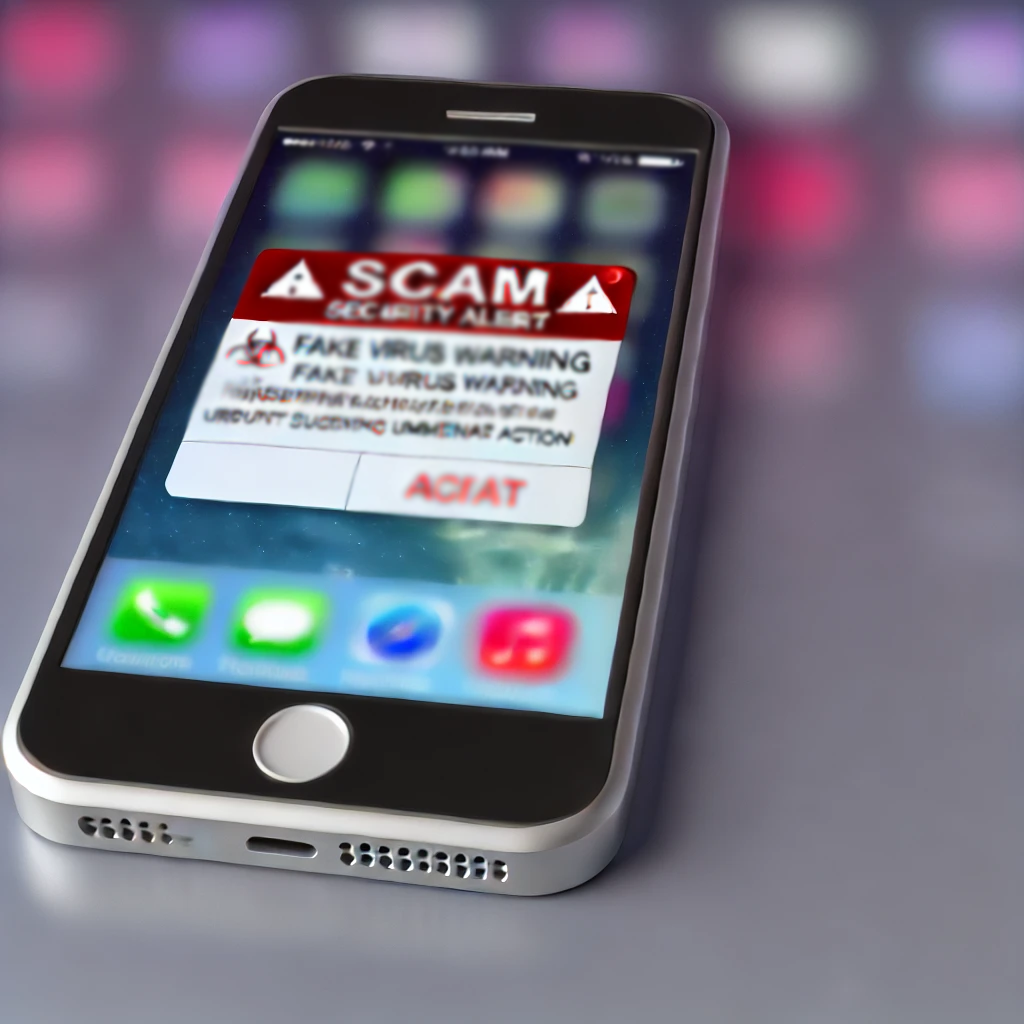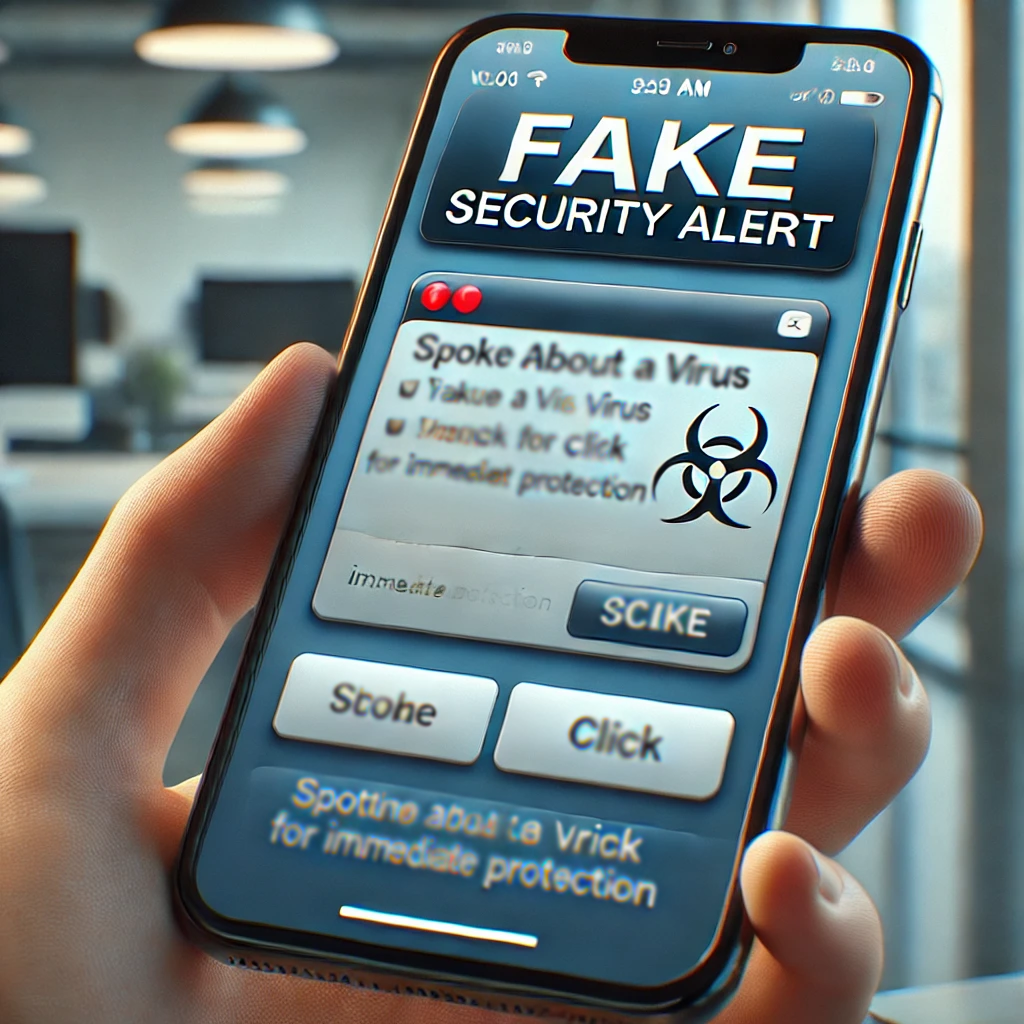iPhone Security Alert Scam Pop up
In recent years, there has been a noticeable rise in iPhone security alert scams, catching many users off guard. These scams, which often manifest as ominous pop-ups or alerts, claim that your device has been compromised or infected with a virus. Unfortunately, the sophistication of these scams has evolved, making them more convincing and harder to immediately identify as fraudulent. The alerts might mimic the aesthetics of legitimate Apple iPhone security alerts, leading to increased risks of personal data breaches.
Understanding and identifying this fake security alert on iPhone is crucial for protecting your personal information. Many of these alerts are specifically designed to induce panic, prompting a quick reaction that could lead to compromised personal details. Common examples include virus messages on iPhone that may suggest immediate action to ‘clean’ the device, or pop-ups about a detected security threat, urging you to install dubious software or visit an unsafe website.
The intent of this blog is to empower you, the reader, with the knowledge to differentiate between real and fake security alert on iPhone. We will explore the visual and textual cues that distinguish genuine Apple warnings from scams, discuss the common narratives that scammers use, such as the iPhone virus pop up warning, and provide you with the necessary tools to respond effectively without jeopardizing your device’s security or your personal data. By the end of this blog, you’ll be equipped to navigate the troubling waters of iPhone virus scam pop ups with confidence and caution.
Understanding iPhone Security Alert Scam pop ups
iPhone security alert scams involve deceptive alerts that pop up on your device, falsely claiming that your iPhone has encountered a security issue. These scams can manifest in different forms, including security alert on iPhone notifications that closely mimic the look and feel of legitimate Apple iPhone security alerts. The objective of these fraudulent alerts is to trick users into providing personal information, downloading malicious software, or paying for unnecessary technical support services.
 Common types of these scams include phishing attempts, where the scam pop-up tries to lure you into entering your personal details under the guise of verifying your identity. Malware alerts are another frequent scam tactic, falsely informing you that your device has been infected and urging you to download a rogue app to remove the supposed threat. Additionally, users might encounter scams promising fake prizes, which ask them to fill out forms or pay a small fee to claim a reward that does not exist.
Common types of these scams include phishing attempts, where the scam pop-up tries to lure you into entering your personal details under the guise of verifying your identity. Malware alerts are another frequent scam tactic, falsely informing you that your device has been infected and urging you to download a rogue app to remove the supposed threat. Additionally, users might encounter scams promising fake prizes, which ask them to fill out forms or pay a small fee to claim a reward that does not exist.
Statistical data on the prevalence and impact of these scams is alarming. According to cybersecurity reports, over 60% of mobile phishing attacks target iOS devices, predominantly through fake Apple iPhone virus warnings and fake security warnings on iPhone. These figures underscore the importance of staying vigilant and recognizing the signs of such scams. The damages extend beyond just financial loss; the theft of personal information and identity fraud are long-lasting consequences that can severely disrupt lives.
By understanding the various manifestations and methods of these scams, users can better secure themselves from falling victim. Whether it’s an iPhone security alert scam pop up claiming a virus has been detected, or a more subtle virus message on iPhone suggesting system compromises, recognizing these red flags is the first step in safeguarding your digital life. The key is to remain cautious and verify the authenticity of any unsolicited security messages before taking action.
How iPhone Security Alert Scams Work
Understanding the mechanisms behind iPhone security alert scams is crucial for users to effectively dodge these deceptive threats. Let’s delve into a detailed step-by-step explanation of how these iPhone virus alert scams are meticulously engineered to exploit users.
-
Initiation of the iPhone virus alert Scam:
The scam typically begins with a sudden iPhone pop up virus warning while you’re browsing the internet or using an app. These pop up virus warnings on iPhone are designed to imitate genuine Apple interface elements, making them appear legitimate at first glance. An example of such a message might be: “Security Warning on iPhone: Immediate action required!”
-
Mimicking Genuine iPhone Security Alerts:
To enhance their credibility, these iPhone virus scam pop ups replicate the look and feel of real Apple iPhone security alerts. They might incorporate Apple’s logo, use similar typography, and mimic the tone and language of official Apple iPhone virus warnings to convince you of their authenticity.
-
Creating Urgency and Fear:
A key strategy employed in these scams is the use of psychological manipulation. The iPhone virus alert scam often includes messages that instill a sense of immediate danger, such as “Your iPhone has been infected with a virus! Click here to clean your device!” This tactic is intended to make users act hastily, driven by fear of losing personal data or damaging their device.
-
Phishing for Personal Information:
When a user interacts with the fake security alert on iPhone, they might be directed to a malicious site or asked to download a harmful app. These sites often ask for personal information under the guise of securing the user’s device, exploiting the initial virus message on iPhone to phish for sensitive data.
-
Completing the Scam:
If the user follows through by entering personal information or downloading the app, the scammers achieve their goal. The user’s data is now compromised, ready to be used for illicit activities or sold on the dark web. The iPhone security alert scam pop up has successfully misled another user.
Common Examples of Scam Messages:
-
- “iPhone virus pop up warning: Your device is infected by four viruses! Immediate cleaning is required.”
- “Security alert on iPhone: Tap here now to prevent permanent damage!”
By increasing awareness of how these iPhone virus alert scams operate and recognizing common iPhone security alert scam pop up messages, users can better protect themselves from falling victim to these clever schemes. Vigilance and skepticism towards unexpected security messages are key defenses against such deceptive tactics.
Identifying Fake Security Alert on iPhone
Recognizing fake security alert on iPhone is essential to safeguard your digital life from cyber threats. These scams often disguise themselves as legitimate alerts but can be spotted by a keen observer aware of certain telltale signs. Let’s explore the key indicators of a scam and how to differentiate between authentic Apple iPhone virus warnings and deceptive alerts.
Key Indicators of a Scam:
-
Poor Grammar and Spelling Errors:
Authentic security warning on iPhone is professionally written and thoroughly checked for grammatical accuracy. In contrast, fake iPhone security alert often contain spelling mistakes and awkward phrasing, which are red flags indicating a fraudulent alert.
-
Unprofessional Visuals:
Genuine alerts from Apple feature high-quality graphics and a consistent visual style that matches the iOS interface. On the other hand, iPhone virus scam pop ups may display low-resolution images, mismatched fonts, or an overall unprofessional appearance that does not align with Apple’s design standards.
-
Excessive Urgency:
Scammers frequently use urgent and alarming language to create a sense of immediate danger. Messages like “Immediate action required!” or “iPhone virus pop up warning: Your device is at risk!” are designed to provoke quick reactions without giving you time to think about the legitimacy of the alert.
Comparison between Legitimate and Fake Security Alerts on iPhone:
-
Visual Consistency:
Authentic security alert on iPhone is visually consistent and seamlessly integrate into the iOS environment. They use uniform fonts, colors, and layout. In contrast, iPhone security alert scam pop ups may look out of place, featuring unusual button styles or color schemes that do not match other iOS notifications.
-
Content and Messaging:
Real security alert on iPhone provides clear, concise information without demanding immediate action. They guide you to settings or suggest further steps via secure Apple websites. Conversely, iPhone virus alert scams often demand that you immediately download a software or enter personal information on a suspicious website, typically accompanied by dire warnings like “virus message on iPhone: Tap here to fix now!”
-
Request for Personal Information:
A significant red flag is when a pop-up or alert asks for personal information or payment. Apple iPhone virus warnings will never solicit personal details directly through a pop-up. Any security alert on iPhone that asks for your Apple ID, password or payment card details under the pretext of resolving a security issue is undoubtedly a scam.
By understanding these distinctions and remaining vigilant, you can effectively recognize and avoid falling victim to fake iPhone virus message pop ups and other similar scams. Always take a moment to assess the authenticity of any alert before taking action, and when in doubt, contact Apple Support directly for verification.
Immediate Steps to Take if You get fake Security Alert on iPhone
When you encounter a fake security alert on iPhone or a suspicious iPhone virus alert pop up, it’s crucial to know the immediate steps to take to safeguard your device and personal information. Here’s what you should do if you suspect that an alert on your iPhone is part of a scam:
-
Do Not Interact with the Pop-Up:
If a pop up that says iPhone has virus or any bogus security alert on iPhone appears, the first rule is not to tap on any part of the notification, not even the dismiss button. Scammers can design pop-ups to trigger software downloads or redirect you to malicious websites even through seemingly harmless interactions.
-
Close the Suspicious Alert Safely:
To close out a fake security alert on iPhone, use the iOS task switcher. Double-click the Home button (on models with a Home button) or swipe up to the middle of the screen and hold (on models without a Home button) to start the app switcher. Then, swipe up on the browser or app preview to close it completely. This method avoids any interaction with the pop-up itself.
-
Clear Your Browser History and Data:
After closing the suspicious app or browser, clear your history and web data to remove any residual traces of the iPhone virus alert scam message. Go to Settings > Safari, and tap ‘Clear History and Website Data’. For other browsers, follow the respective settings to clear cache and cookies.
-
Update Your Security Settings and Software:
Ensure your iPhone’s operating system and all apps are up-to-date to protect against vulnerabilities. Regular updates often include security patches that prevent scams and malware attacks. Visit Settings > General > Software Update and download any available updates.
-
Report the Scam to Apple:
Reporting the fake iPhone virus warning pop up helps improve security for all users. Capture a screenshot of the pop-up and send it to Apple via the official support channels. This documentation can help Apple track scam patterns and potentially block malicious sources.
-
Contact Support for Confirmation and Assistance:
If you’re unsure whether a virus message on iPhone is legitimate, contact Support directly for clarification. It’s important to use official Apple contact routes or a genuine third-party support service, like us to verify any suspicions about Apple iPhone virus warnings or security messages.
-
Educate Yourself About Ongoing Scams:
Regularly updating your knowledge about the latest scam tactics can prevent future scares. Apple’s official website and trusted cybersecurity resources offer updates and tips on recognizing and handling various scams.
By taking these steps, you can successfully respond to and mitigate the impact of fake security alert on iPhone and other similar scams. Staying informed and cautious is your best defense against these increasingly sophisticated threats.
Long-term Strategies to Protect Your iPhone from Scams
To safeguard your iPhone against the evolving threats posed by scammers, it’s vital to implement a series of proactive measures. These long-term strategies not only enhance your device’s security but also prepare you to effectively counter potential scams. Below are key steps to fortify your iPhone against the likes of Apple iPhone virus warnings, Trojan virus alerts on iPhone, and other deceptive tactics.
-
Stay Updated with Regular Software Updates:
One of the most effective defenses against scams, including fake security alert on iPhone, is to keep your iOS software up to date. Apple frequently releases updates that patch security vulnerabilities and enhance overall system resilience. Enabling automatic updates under Settings > General > Software Update ensures that your device receives these important security patches as soon as they are available.
-
Utilize Reliable Security Apps and Settings:
While iPhones are designed with strong security features, augmenting this with reliable security apps can provide an additional layer of protection. Choose reputable security software that offers features like phishing scam detection, web filtering, and virus protection. Additionally, adjust your iPhone settings to limit exposure to threats; for instance, disable installation of apps from unknown sources and use the built-in Security and Privacy settings to manage app permissions effectively.
-
Beware of Fake Security Alerts on iPhone:
Scammers often use fake security alerts on iPhone to instill panic and trick users into compromising their security. Familiarize yourself with the look and feel of legitimate alerts from Apple and scrutinize any message that deviates from this standard. Be skeptical of any pop-ups claiming to detect viruses or offering unsolicited security advice.
-
Educate yourself and Others About iPhone Security Alert Scam Messages:
Continuous education on the latest scam tactics and security threats is crucial. Subscribe to cybersecurity news, follow trusted security blogs, and take part in community forums to stay informed about new scams like the iPhone virus alert scam or Apple iPhone security alert scam pop up. Sharing this knowledge with family and friends amplifies community resilience against these scams.
-
Responding to Trojan Virus Alert on iPhone:
If you ever encounter a Trojan virus alert on iPhone, it’s crucial to verify its authenticity before taking any action. Contact Apple Support directly to confirm whether the alert is genuine or part of a scam. This practice should be standard for any security warning on iPhone that requests personal information or directs you to download software.
By adopting these strategies, you can significantly minimize the risk of falling victim to clever scams like the iPhone virus alert scam. Regular updates, vigilant app management, and ongoing education are your best tools in maintaining not just the security of your iPhone, but also the integrity of your personal information.
FAQs
Q1. What is an iPhone security alert scam?
- A. An iPhone security alert scam involves fraudulent alerts, often appearing as pop up virus warning on iPhone, designed to deceive users into providing personal information, downloading malware, or paying for unnecessary services.
Q2. How can I recognize a fake security alert on my iPhone?
- A. Fake security alert on iPhone often contains poor grammar, unprofessional visuals, or create a sense of urgency. Unlike genuine Apple iPhone security alerts, these scams may aggressively ask you to act immediately.
Q3. What should I do if I receive a virus message on iPhone?
- A. If you receive a virus message on iPhone, do not interact with the pop-up. Instead, close the app or browser using the app switcher, clear your browser data, and report the incident to the Support for verification.
Q4. How can I differentiate between an Apple iPhone virus warning and a scam?
- A. Genuine Apple iPhone virus warnings are subtle and professional, without demanding immediate action. Scams, however, may use alarming language and insist that you must act quickly, often linked with a pop up that says iPhone has a virus.
Q5. Are iPhone virus pop up warnings always scams?
- A. Not all iPhone virus pop up warnings are scams, but it’s important to be cautious. Verify any alerts by contacting Apple Support directly and avoid providing personal information or downloading software from the pop-up links.
Q6. What are the most common types of iPhone virus alert scams?
- A. Common types include iPhone virus alert pop ups, security alert on iPhone, and Trojan virus alert on iPhone, all crafted to trick you into believing your device is at immediate risk and prompt you to take unsafe actions.
Q7. Can a pop up virus warning on iPhone actually harm my device?
- A. The pop up virus warning on iPhone itself cannot harm your device, but interacting with it (like clicking on links or downloading suggested apps) can lead to malware installation or data theft.
Q8. What long-term measures can I take to protect against iPhone virus scams?
- A. Regularly update your iPhone’s software, use trusted security applications, and educate yourself about ongoing iPhone virus alert scams to enhance your device’s defenses against such threats.
Q9. How do I report an iPhone virus warning pop-up I suspect is a scam?
- A. Capture a screenshot of the iPhone virus warning pop up and send it to Apple Support. Also, consider using Apple’s official reporting channels to alert them about the suspected scam.
Q10. Why is it important to be skeptical of any security warning on iPhone?
- A. Being skeptical helps you avoid falling victim to iPhone virus alert scams. Scammers often create fake alerts, like Apple iPhone Trojan virus warnings, to exploit your fears and trick you into making security mistakes.
Conclusion
Throughout this blog, we’ve explored the various aspects of iPhone security alert scams, emphasizing the critical need to differentiate genuine Apple iPhone security alerts from deceptive fake security alerts on iPhone. It’s essential to remain vigilant, as scammers are constantly developing more sophisticated techniques. They often create bogus virus message on iPhone that mimic real security alert on iPhone, leveraging fear to provoke immediate reactions from users.
To combat these threats, staying informed is important. Regularly updating your knowledge through trusted cybersecurity sources and Apple’s updates can help you stay alert to new threats. Ensuring that your iPhone’s software is up-to-date is crucial in protecting against the vulnerabilities that scammers aim to exploit. These updates often include patches that close security loopholes and enhance your device’s defenses against potential iPhone virus alert scams.
Moreover, educating yourself and others on how to recognize and respond to iPhone security alert scams and virus alert scam pop ups can build a knowledgeable community capable of resisting these frauds. In case of any confusion, you can feel free to call our customer support number mentioned on our Apple Support page. Our support team will provide assistance to effectively tackle such situations. Your awareness and proactive measures are your best defense against these scams. Approach every unexpected security alert with caution, particularly those that demand urgent action, to maintain a secure and uninterrupted mobile experience.

